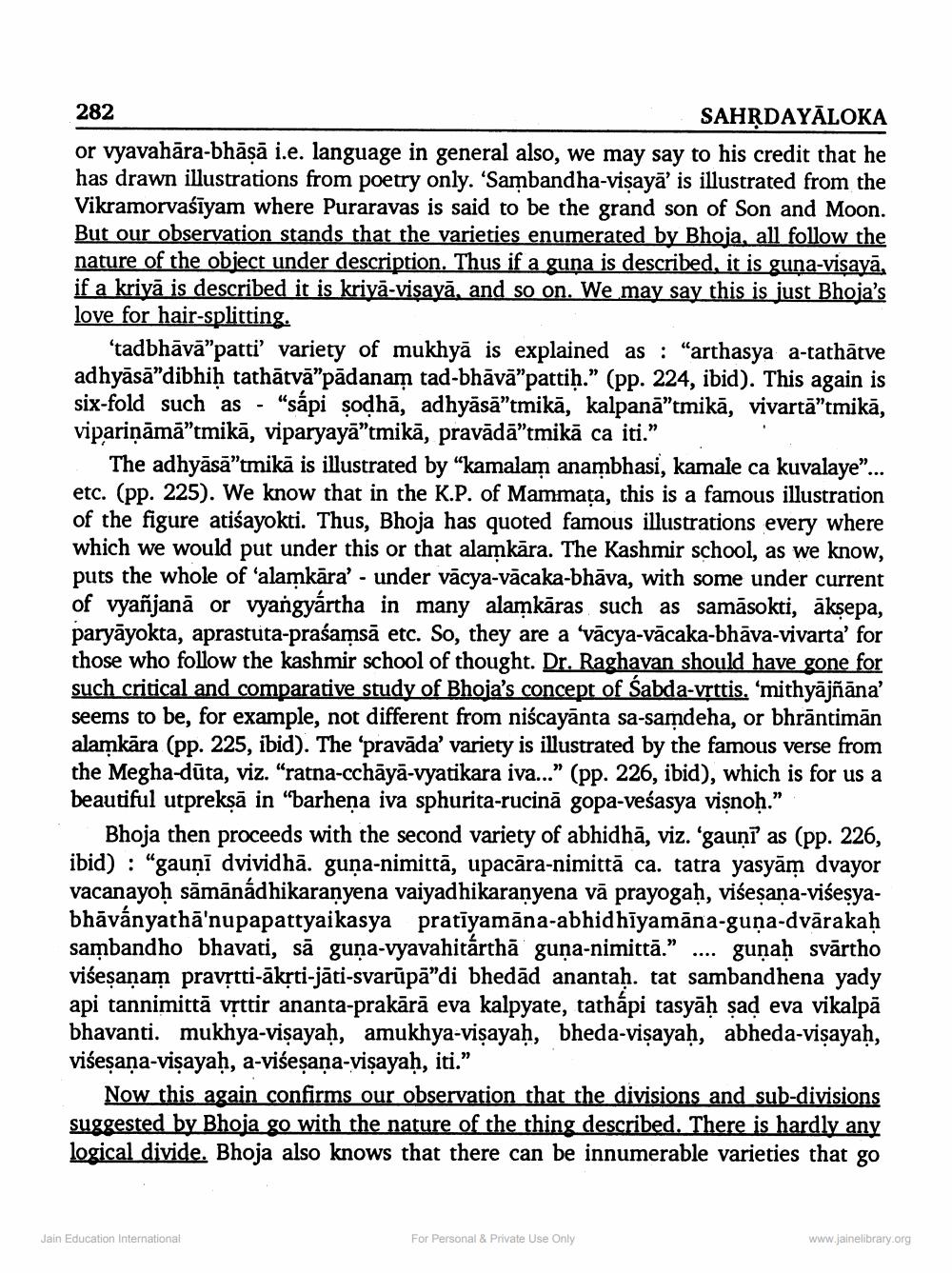________________
282
SAHṚDAYALOKA or vyavahāra-bhāṣā i.e. language in general also, we may say to his credit that he has drawn illustrations from poetry only. 'Sambandha-viṣaya' is illustrated from the Vikramorvaśīyam where Puraravas is said to be the grand son of Son and Moon. But our observation stands that the varieties enumerated by Bhoja, all follow the nature of the object under description. Thus if a guna is described, it is guna-visayā, if a kriya is described it is kriya-viṣayā, and so on. We may say this is just Bhoja's love for hair-splitting.
'tadbhāvā"patti' variety of mukhyā is explained as "arthasya a-tathātve adhyāsā"dibhiḥ tathātvā"pādanam tad-bhāvā"pattiḥ." (pp. 224, ibid). This again is six-fold such as - "sápi ṣoḍha, adhyāsā"tmikā, kalpanā"tmikā, vivartā❞tmikā, vipariņāmā"tmikā, viparyayā”tmikā, pravādā❞tmikā ca iti."
The adhyāsā"tmika is illustrated by "kamalam anambhasi, kamale ca kuvalaye"... etc. (pp. 225). We know that in the K.P. of Mammața, this is a famous illustration of the figure atiśayokti. Thus, Bhoja has quoted famous illustrations every where which we would put under this or that alamkara. The Kashmir school, as we know, puts the whole of 'alamkara' - under vācya-vācaka-bhāva, with some under current of vyañjana or vyangyártha in many alamkāras such as samāsokti, ākṣepa, paryāyokta, aprastuta-praśamsă etc. So, they are a 'vācya-vācaka-bhāva-vivarta' for those who follow the kashmir school of thought. Dr. Raghavan should have gone for such critical and comparative study of Bhoja's concept of Śabda-vṛttis. 'mithyājñāna' seems to be, for example, not different from niscayanta sa-samdeha, or bhrāntimān alamkāra (pp. 225, ibid). The 'pravāda' variety is illustrated by the famous verse from the Megha-dūta, viz. “ratna-cchāyā-vyatikara iva..." (pp. 226, ibid), which is for us a beautiful utprekṣā in "barheṇa iva sphurita-rucina gopa-veśasya visnoḥ."
Bhoja then proceeds with the second variety of abhidhā, viz. 'gauņi as (pp. 226, ibid) "gauņi dvividhā. guṇa-nimittā, upacara-nimittă ca. tatra yasyam dvayor vacanayoḥ sāmānádhikaranyena vaiyadhikaranyena vā prayogaḥ, viseṣaṇa-viśesyabhāványathā'nupapattyaikasya pratīyamāna-abhidhīyamāna-guṇa-dvārakaḥ sambandho bhavati, sā guṇa-vyavahitárthā guṇa-nimittā." guṇaḥ svartho viseṣaṇam pravṛtti-ākṛti-jāti-svarūpā"di bhedad anantaḥ. tat sambandhena yady api tannimittā vṛttir ananta-prakārā eva kalpyate, tathápi tasyāḥ ṣad eva vikalpā bhavanti. mukhya-viṣayaḥ, amukhya-viṣayaḥ, bheda-viṣayaḥ, abheda-viṣayaḥ, viseṣaṇa-visayaḥ, a-viseṣaṇa-visayaḥ, iti."
Now this again confirms our observation that the divisions and sub-divisions suggested by Bhoja go with the nature of the thing described. There is hardly any logical divide. Bhoja also knows that there can be innumerable varieties that go
Jain Education International
....
For Personal & Private Use Only
www.jainelibrary.org




